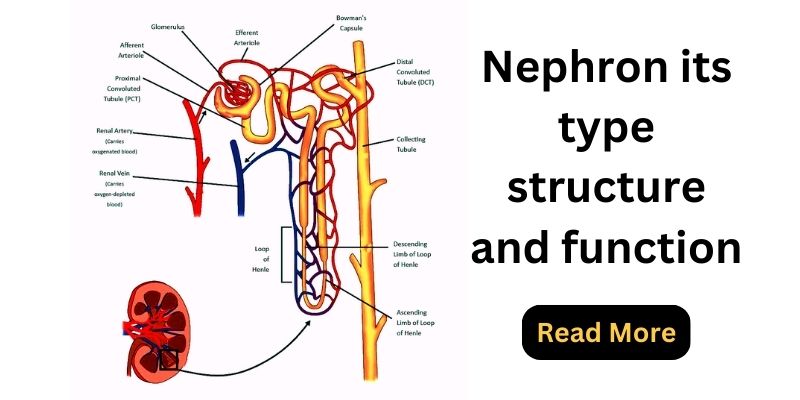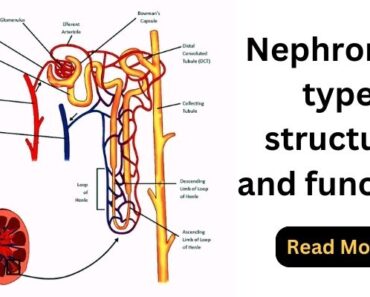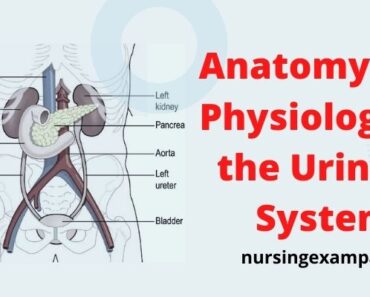What is Nephron? – This is the functional unit of the kidney, the organ responsible for filtering blood and removing waste products and excess fluids from the body. Each kidney contains about a million nephrons, which are arranged in clusters called renal corpuscles.
Each nephron is made up of several parts, including the glomerulus, Bowman’s capsule, proximal convoluted tubule (PCT), the loop of Henle, distal convoluted tubule (DCT), and collecting duct. These parts work together to filter the blood and eliminate waste products and excess fluids from the body. They are also involved in the process of osmoregulation, which involves maintaining the balance of fluids and electrolytes in the body.

The nephrons are essential for maintaining the health of the body by removing waste products and excess fluids from the bloodstream. They also play a crucial role in regulating blood pressure and the production of red blood cells. Dysfunction or damage to the nephrons can lead to a variety of kidney-related health problems, such as kidney failure or chronic kidney disease.
Structure of nephron/parts and function
The nephron is the functional unit of the kidney and is responsible for filtering blood and removing waste products and excess fluids from the body. Each nephron is made up of several parts, including:
Anatomy of the Nephron:
- Renal Corpuscle:
- The renal corpuscle is the initial part of the nephron where blood filtration occurs. It consists of two main structures:
- Glomerulus: A network of capillaries formed by arterioles entering and exiting the renal corpuscle. The glomerulus is surrounded by Bowman’s capsule.
- Bowman’s Capsule: A double-walled cup-shaped structure that surrounds the glomerulus. The inner layer called the visceral layer, is made up of specialized cells called podocytes, which have foot-like projections (pedicels) that wrap around the capillaries of the glomerulus. The space between the visceral and parietal layers of Bowman’s capsule is called the Bowman’s space, which collects the filtrate that is formed from the blood.
- The renal corpuscle is the initial part of the nephron where blood filtration occurs. It consists of two main structures:
- Renal Tubule:
- After the filtrate is formed in Bowman’s capsule, it enters the renal tubule, which is a long and convoluted structure that processes the filtrate further. The renal tubule is divided into several segments:
- Proximal Convoluted Tubule (PCT): The first segment of the renal tubule. It is lined with cuboidal epithelial cells with microvilli (brush border) on the luminal surface. This segment is responsible for reabsorbing most of the filtered nutrients (glucose, amino acids), ions (sodium, chloride), and water back into the bloodstream.
- Loop of Henle: The loop of Henle is a U-shaped hairpin loop that extends into the renal medulla. It is divided into:
- Descending Limb: Descends into the medulla, and is permeable to water but not to ions.
- Ascending Limb: Ascends back towards the cortex. The thick ascending limb is impermeable to water but actively transports ions such as sodium, potassium, and chloride out of the tubular fluid into the interstitial space.
- Distal Convoluted Tubule (DCT): The segment of the renal tubule that follows the loop of Henle. It is involved in the further reabsorption of ions and water, as well as the secretion of certain substances into the tubular fluid.
- Collecting Duct: Receives urine from several nephrons and carries it through the medulla to the renal pelvis. The collecting ducts are responsible for fine-tuning the final concentration of urine based on the body’s hydration status through reabsorption of water regulated by antidiuretic hormone (ADH).
- After the filtrate is formed in Bowman’s capsule, it enters the renal tubule, which is a long and convoluted structure that processes the filtrate further. The renal tubule is divided into several segments:
Functions of the Nephron:
- Filtration: Blood enters the glomerulus under pressure, and small molecules like water, ions, glucose, amino acids, and waste products are filtered into Bowman’s capsule to form filtrate.
- Reabsorption: Essential substances like glucose, amino acids, and the majority of filtered water are reabsorbed from the renal tubules back into the bloodstream.
- Secretion: Certain substances such as ions (e.g., potassium, hydrogen ions) and drugs are actively transported from the blood into the renal tubules to be excreted in urine.
- Excretion: The remaining filtrate, which now contains waste products and excess substances, is modified through processes in the renal tubules and collecting ducts to form urine, which is eventually expelled from the body.
Together, these parts of the nephron work to filter the blood and eliminate waste products and excess fluids from the body. They also help to maintain the balance of fluids, electrolytes, and other substances in the body and regulate blood pressure. Dysfunction or damage to the nephrons can lead to a variety of kidney-related health problems, such as kidney failure or chronic kidney disease.
Types of nephrons
There are two types of nephrons in the human kidney: cortical nephrons and juxtamedullary nephrons.
Cortical nephrons:
Cortical nephrons are one of two types of nephrons in the human kidney. They are located in the outer layer of the kidney, called the cortex, and makeup about 85% of all nephrons in the kidney. Cortical nephrons have a relatively short loop of Henle, which means that they do not extend as deeply into the renal medulla as juxtamedullary nephrons. As a result, they are less efficient at regulating the concentration of the glomerular filtrate.
Cortical nephrons are responsible for filtering blood and removing waste products and excess fluids from the body. They are involved in the process of osmoregulation, which involves maintaining the balance of fluids and electrolytes in the body. Cortical nephrons are also involved in the regulation of blood pressure and the production of hormones that help to regulate blood pressure and electrolyte balance.
Cortical nephrons are made up of several parts, including the glomerulus, Bowman’s capsule, proximal convoluted tubule (PCT), distal convoluted tubule (DCT), and collecting duct. Together, these parts work to filter the blood and eliminate waste products and excess fluids from the body.
Juxtamedullary nephrons:
These nephrons are one of two types of nephrons in the human kidney. They are located in the inner layer of the kidney, called the medulla, and makeup about 15% of all nephrons in the kidney. Juxtamedullary nephrons have a relatively long loop of Henle, which means that they extend deeper into the renal medulla than cortical nephrons. This allows them to be more efficient at regulating the concentration of the glomerular filtrate.
Juxtamedullary nephrons are responsible for filtering the blood and removing waste products and excess fluids from the body. They are involved in the process of osmoregulation, which involves maintaining the balance of fluids and electrolytes in the body. Juxtamedullary nephrons are also involved in the regulation of blood pressure and the production of hormones that help to regulate blood pressure and electrolyte balance.
Juxtamedullary nephrons are also made up of several parts, including the glomerulus, Bowman’s capsule, proximal convoluted tubule (PCT), the loop of Henle, distal convoluted tubule (DCT), and collecting duct. Together, these parts work to filter the blood and eliminate waste products and excess fluids from the body.
Both types of nephrons are responsible for filtering the blood and removing waste products and excess fluids from the body. However, juxtamedullary nephrons are more important for regulating the concentration of the glomerular filtrate and maintaining the balance of fluids and electrolytes in the body.
How many nephrons are present in each kidney and what is the length and diameter of each
The kidneys are a pair of organs located in the abdominal cavity, just below the ribcage. They are responsible for filtering waste products and excess fluids from the blood, regulating blood pressure, and controlling the production of red blood cells. Each kidney is made up of millions of tiny filtering units called nephrons. The number of nephrons in each kidney can vary, but the average adult has about 1 million nephrons per kidney.
The length of a nephron can vary, but they are generally around 0.5 cm in length. The diameter of a nephron is also relatively small, typically measuring around 0.2 cm. The nephrons are arranged in clusters called renal corpuscles, which are surrounded by a network of small blood vessels called the glomerulus. The glomerulus is responsible for filtering blood and removing waste products and excess fluids, which are then eliminated from the body through the urinary system.
How do you count nephrons?
It is not possible to count the exact number of nephrons in a living person’s kidneys because they are too small and are not visible to the naked eye. In addition, the nephrons are embedded deep within the kidney tissue, making it difficult to access them.
To count the number of nephrons in a kidney, the kidney must be dissected and carefully examined under a microscope. This process is called histological examination, and it involves preparing thin slices of kidney tissue and staining them with special dyes to make the nephrons visible. The number of nephrons can then be counted by carefully examining the tissue slices under a microscope.
This method is typically used for research purposes or to study the effects of different conditions or treatments on the kidneys. It is not practical to count the number of nephrons in a living person’s kidneys for diagnostic or treatment purposes.
Read Also –
Anatomy and Physiology of the Urinary System
Urinary System Multiple-Choice Questions
Blood Transfusion – Complication – Precautions and Responsibility.






